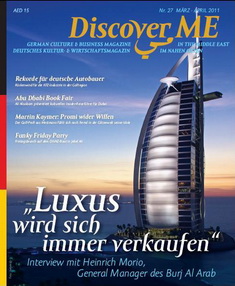
Article:
ISSUE No.3 March - April 2007
My Home is my Castle
Arab Design Ideas versus German Functionality
In Europe, the most diverse, architectural styles have emerged over the centuries. Extreme domestic situations led to extreme designs. The playful, flamboyant rococo and baroque periods alternated with clear, linear eras such as classicism and Bauhaus.
Each era boasts its own style. During the reign of Louis XIV, the new-found wealth was manifest in forms and, therefore, also in the domestic style. An abundance of colourful furnishings found their way into the drab homes. Prominent furniture decorated with magnificent, gold rooms and voluminous garments began to appear.
The 1970s were dominated by bright signal colours; it was impossible to imagine a household without orange tones and they cropped up in carpets, furniture, walls and even clothing. The wild 70s were in stark contrast to the more conservative post-war period. The social change brought bright and iridescent colours in its wake.
Consequently, Europe has been able to try out and explore different stylistic directions over the centuries. Individual taste is cultivated from a young age and the trained eye knows exactly which style the house should be modelled on later in life. Decorations from the Danish, French, Mediterranean or the sober Bauhaus school of design are very popular.
In the meantime, Germans in particular attach great importance to practical, functional and ecologically harmless domestic arrangements. High rents and expensive land and building costs force some to choose a small home for themselves and their families. Filigree furniture decorates the homely apartments and the classic wall closet, can be found in most living rooms.
But what about our host country, the United Arab Emirates? How do the Emiratis furnish their big houses?
To answer this question, we need to look at the Emirates’ past. Bedouins were travelling from place to place with their caravans through the desert until as recently as the 1970s. They lived in tents and led simple lives, mostly in poverty. The same applies to the fishermen on the coast or the townsfolk who lived in little clay houses. However, life changed with the discovery of oil during the last century. Immeasurable wealth has flooded the country ever since. The living conditions improved and no one had to go without any longer. The same phenomenon that we all know from Europe after the long years of war can now be observed here. The new-found wealth is flaunted. Let’s go the whole hog! The buzzword is big. Emirati landowners now had the means to build enormous mansions, which literally sprouted from the ground. Even smaller Arab houses look like palaces. Generously furnished entrance halls lead to spacious living rooms. This layout has a social and cultural background. Emirati families live in big family groups. Children rarely move out before starting a family of their own. Consequently, big houses are built out of necessity. On the one hand, they guarantee comfort; on the other hand they serve as status symbols.
On entering the huge living room, the guest’s attention is drawn to inviting, luxurious sofa accessories. The room as such is rather sober and the beloved wall closet of the Germans is a rare sight in an Arab sitting room. Thick, soft carpets cover the floor but the walls are usually bare.
The emphasis is on communication. Family gatherings take place in the large living rooms, where people sit on the sofas for hours or settle down on the floor in the old Bedouin fashion. In traditional Arab families, meals are taken on the floor.
Heavy, opulent and squiggled furniture fills giant rooms and lavish, ornate and often brilliant cushions decorate the sofas. Consequently, in Arab homes the emphasis is on beauty, not functionality.
However, influenced by the British colonials, no individual furnishing style has really emerged over the last 35 years. Often, local houses are a mixture of many different stylistic directions, which Germans may perceive as a mess. Inspired by the Indian imperial style, Emirati homeowners developed a passion for dark wood. However, combinations of Persian, Egyptian, Syrian and Lebanese styles can also be found in their houses, especially the filigree intarsia work, accessories, tables or other pieces of furniture.
Red and gold are typical Arab colours. The fact that gold is a sign of affluence goes without saying but where does the affection towards red come from? On the one hand, red is regarded as a signal colour; on the other hand, it also represents warmth and energy. Cushions or tents are often adorned with geometric forms in red and black.
Another difference between German and Arab interior design is found in the use of the kitchen. The kitchen is especially important to Germans, who spend most of their time there. They cook, communicate and sit together in the kitchen. Until the 1950s and 1960s, the living room was only opened and guests or family members invited inside on special occasions to preserve the expensive furniture so everything went – and indeed still goes - on in the kitchen. Occasionally, architects tried to create more space by making the kitchens smaller but this trend is declining. The young generation of Germans also love spacious kitchens and use them as a centre of communication.
This is unthinkable for Arab women. The domestics work in the kitchen, the lady of the house only entering the room to make sure everything is alright or issue instructions to the staff but never to entertain guests.
